| Author |
Message |
Sean Flynt

|
|
   |
 |
|
Bob Gresh
Location: Washington, DC Joined: 08 Jan 2006
Posts: 6
|
 Posted: Mon 09 Jan, 2006 8:40 pm Post subject: kern darts Posted: Mon 09 Jan, 2006 8:40 pm Post subject: kern darts |
 |
|
In response to Sean's 2004 thread on Irish darts, I offer some thoughts. The darts carried by Neil O'Neill and servant in the 1680 painting seem to have bronze heads, though George Gush thought they might be gilded. Actually, "The use of copper, brass or bronze to solder and/or plate iron is not widespread, but is known from some Irish weapons, including the hilts of 16th century swords and some arrowheads, and it is probably justifiable to regard it as an Irish technique of sixteenth century date." So wrote Etienne Rynne in the article "Three Irish knife-daggers" in the 1969 Journal of the Royal Society of Antiquaries of Ireland. The daggers in question--skeans--had wood handles bound with iron ferrules soldered and plated with copper alloy. Hayes-McCoy, in a personal communication, pointed out to Rynne that this bronze plating appears on some irish 16th century sword hilts and arrowheads, including a forked one much resembling the forked arrowhead under the warrior's arm in the famous Durer drawing of 1521.
And there is a strange series of cast bronze maceheads from medieval Gaelic contexts, though they date to a couple centuries before this 16th century material. They could indicate a Gaelic proclivity to use bronze in weaponry.
There are many names for spears and darts in Irish. Halpin, in "Native Irish Arms and Armour.." did his best to classify them. Very difficult as writers were not particularly diciplined in their use of vocabulary, but he could say that ga, gae or foga, to give it the particle, was a kind of dart. Birin (bir-een) was another word for these. Sleag was a slender spear, thrust or thrown. And craisech (cree-sach) is a heavier spear, used for pushing and boring, and sometimes carried by horsemen, retained after they have flung their gae. The ties of "full hard flax" cord, called suaineamh (soonev) were what the Romans called ammentum. They were lashed on mid-shaft for sleags and towards the butt for gae or birin. A cord was wound around the shaft several times, securing a loop about three inches long. The forefinger of the right hand was inserted into the loop, and added to the force of the cast. Unlike the arrow-throwing Yorkshire miners of the 19th century, the Irish finger-loops went with the javelin, and did not unwind. My impression is that three of the smaller gae would be carried, or two of the tall sleag, the "Da Sleag" of heroic tales.
There are several period illustrations showing a type of dart about 4-5 feet long, with fletching. This type is never pictured with a finger loop. An Irish lackey in London, pictured by Hieronymous Tielch in 1603, carries this dart with a slender, even shaft almost 5 feet long, with a long narrow, barbed head and two triangular vanes sweeping back, about 5 inches long and 3-4 inches high. The butt extends a few inches back beyond the end of the vanes. A 1548 sketch from Andrew Boorde's "The fyrst boke.." shows a kern with a similarly sized dart with identical vanes and shaft, and what looks like a pyrimidal, faceted head, rather short. This is probably the origin of the reenactor's bodkin type, pyrimidal dart heads. I saw the ceremonial Dart of Cork city in 1984, and it also was of this type, much resembling Tielch's. It was a good 5 feet long. The slender, light colored shaft began to taper towards the butt, starting at the last 6 inches or so. The two vanes were in imitation of peacock feathers, with the eye replaced by the seal of Cork on one and a harp in shamrock wreath on the other. They were pretty florid, but were of a type with the triangular vanes of Tielch and Boorde. The head was large and of the broad head type. The figure of Death, a skeleton with a sand clock in one hand and a dart in the other, always carries this type of dart. In the Elizebethan play, Rowland's "Look to it or I'll stab ye", he has death say "But at the Irish Dart I onely deal." Regarding reenactor darts, i find this SCA description from 1994 "It was about three feet long, with a fairly heavy shaft, and a "broadhead" point. It might or might not be flecthed with leather or parchment." I will post a photo of recent irish reenactors using this type of dart. Some of theirs seem to have cord twisted round the lenght of the shaft, and i mean to discover the origin of this idea.
Finally, a couple of Irish families retain the dart as a crest in their arms: the O'Donnels and McCloskeys. I will post the O'Donnel arms, showing the form of this armorial dart. It is indeed about three feet long, with a knob at the butt end of the rather heavy shaft. It appears flecthed with a couple of gray feathers, and has a broad head of iron. Most interesting is what appears to be a length of bronze wire wound around the shaft right below the head, to give weight in the front end. This would seem to work better, and reminds one that the Yorkshire miner's casting arrows were tapered toward the butt, with their weight in the froward parts. This is the opposite to Neil O'Neill's darts, and it seems only empirical testing--like that done by the guys on the Thrower's Forum--could enlighten us.
|
|
   |
 |
Sean Flynt

|
 Posted: Tue 10 Jan, 2006 7:16 am Post subject: Posted: Tue 10 Jan, 2006 7:16 am Post subject: |
 |
|
That's brilliant info, Bob!
I saw the Cork dart (and an almost identical dart in a nearby coastal city) this fall. If I remember correctly, the tradition of these relatively modern darts involves the mayor ceremonially casting the dart as a symbol of his authority and, supposedly, the amount of land he controls. It's a fascinating survival. Both darts were barrelled, as Bob describes above.
As for the Irish term(s) for the weapon, I'll just point out that the European term for large fletched darts or javelins was "lancegay". That corresponds to the Irish term, possibly suggesting an ancient origin for the word.
-Sean
Author of the Little Hammer novel
https://www.amazon.com/Little-Hammer-Sean-Flynt/dp/B08XN7HZ82/ref=sr_1_1?dchild=1&keywords=little+hammer+book&qid=1627482034&sr=8-1
|
|
   |
 |
Sean Flynt

|
|
   |
 |
Sean Flynt

|
|
   |
 |
|
Bob Gresh
Location: Washington, DC Joined: 08 Jan 2006
Posts: 6
|
 Posted: Tue 10 Jan, 2006 8:15 pm Post subject: Posted: Tue 10 Jan, 2006 8:15 pm Post subject: |
 |
|
Sean:
The 1603 Tielch drawing is in "The Elizabethans and the Irish" by Quinn. I'll try to scan and post it tomorrow. The Boorde woodcut is from his 1548 "Fyrst book ... of Knowledge" and shows a kern with what looks like a bodkin-type point dart. I am attaching it here. The woodcut is not well done, and I favor barbed darts, as in Tielch. But this Boorde woodcut may have guided reenactors who use such a point.
These type of darts were also called "Top Darts" and were used shipboard, cast from the tops. I have seen a 15th century miniature, of the Froissart's Chronicles type, showing a soldier casting such a dart from the crow's nest. It is barbed and has triangular fletching, the fletches being ribbed like feathers. Feathers appear to be indicated in the dart shown as a crest in the O'Donnel arms pictured here:
http://www.araltas.com/features/odonnell/
[url]
For today, I'll attach the Boorde woodcut, and two close-up views of the Neil O'Neill darts. Tomorrow I hope to add good views of reenactors darts.
-Bob Gresh[/url]
 Attachment: 101.29 KB Attachment: 101.29 KB
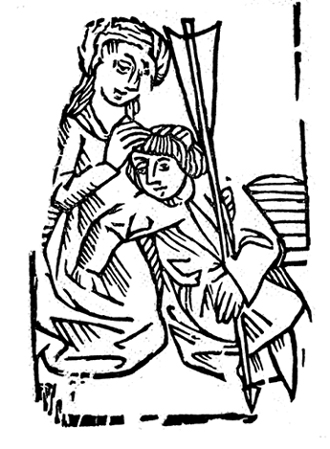
 Attachment: 100.22 KB Attachment: 100.22 KB
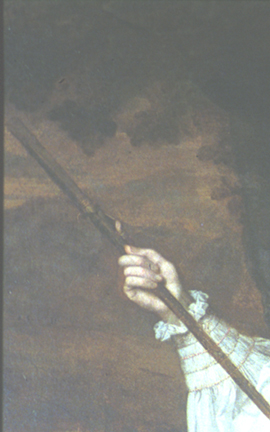
 Attachment: 102.63 KB Attachment: 102.63 KB
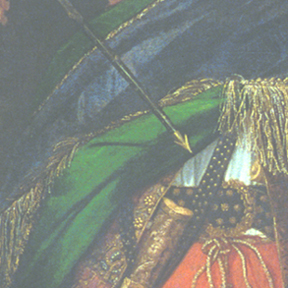
|
|
   |
 |
|
Bob Gresh
Location: Washington, DC Joined: 08 Jan 2006
Posts: 6
|
 Posted: Tue 10 Jan, 2006 8:24 pm Post subject: Posted: Tue 10 Jan, 2006 8:24 pm Post subject: |
 |
|
To All:
Before I forget, have a good look at the close up scan of O'Neill's hand holding his dart. Does the shaft flatten and seem to become spatulate from the finger loop back to the butt? If so, this would change the dynamics of this dart, but I really can't be sure, and I saw this painting in person at the Tate in London. The overall shape of the O'Neill's dart head is like that shown by Tielch, but much smaller.
--Bob Gresh
|
|
   |
 |
Sean Flynt

|
 Posted: Wed 11 Jan, 2006 6:56 am Post subject: Posted: Wed 11 Jan, 2006 6:56 am Post subject: |
 |
|
Wow! These are amazing new (or improved) images! Given the quality of the Boorde woodcut, I think the head could just as easily be interpreted as a broadhead of diamond section rather than a pyramidal form. As for the O'Neill portrait: It's impossible to tell whether the end of the shaft flattens. I would tend away from that interpretation simply on the basis of prefering the simplest explanation when the truth is unknown. However, the absence of fletching suggests that this particular type of dart either was stable in flight with a round section or had some other way to stabilize. Could a flattened section where the fletching would normally be stabilize flight? Any aerospace engineers lurking out there? Russ?
The modified Type 16 arrowheads I've just ordered should be noticeably larger than the one shown in the O'Neill portrait, but it was this portrait that gave me the idea of using the large medieval arrowheads. Other contemporary artwork shows much larger heads and this piece shows what may be one of the smallest (were there specialized heads for war and hunting?). My heads should fall in-between.
Thanks for more great information!
-Sean
Author of the Little Hammer novel
https://www.amazon.com/Little-Hammer-Sean-Flynt/dp/B08XN7HZ82/ref=sr_1_1?dchild=1&keywords=little+hammer+book&qid=1627482034&sr=8-1
|
|
   |
 |
|
Bob Gresh
Location: Washington, DC Joined: 08 Jan 2006
Posts: 6
|
 Posted: Wed 11 Jan, 2006 5:59 pm Post subject: Posted: Wed 11 Jan, 2006 5:59 pm Post subject: |
 |
|
Sean:
I'll post a scan of Tielch's drawing of the Irishman with dart and sword tucked under arm. It is not clear from the original whether the vanes are of leather or feathered. See also a woodcut from Ware's Antiquities of the Kingdom of Ireland, 1790. It shows an Irishman clad like Neil O'Niell in pointed birredh and trews, with a 'lance' and two darts, as Ware says. These darts appear feathered, and they are of a kind with the dart used as a crest in the O'Donnel coat of arms mentioned earlier in this thread. Irish heraldry was adopted in the 17th century, so the dart illustrated in those arms is likley based on not too distant memory. I am particularly interested in what I think is the length of brass wire wrapped just behind the head.
Also, I am putting up a picture of 16th century Irish reenactors out in California (Saint Columcille's) showing the usual reenactor interpretation of these weapons. I notice that some of the shafts have cord wrapped around them for the greater part of their length, and I mean to engage them in a discussion to find out why. I am always eager to pick the brain of anyone else who has considered these weapons. It Matthew Kelty is still out there, maybe he can tell us if there was any difference in performance when just two flights were used, as opposed to three. Most pictures seem to show only two. The reenactors in CA. seem to lash their leather flights on with cord, like arrow flights.
The poorest kerns used simpler projectiles. The story of "O'Donnel's Kern, or the Kern of the Narrow Stripes" which dates to around 1540, describes the down-and-out kern as coming with "three limber javelins (tri gaethe) of holly-wood charred" [i.e., fire-hardened in place of iron-headed, as the editor Standish O'Grady pointed out]. This is a very ancient mode, described by Herodotus and Captain Cook alike. In the South Seas such fire-hardened javelins often taper towards the butt, with their thickest part being the wood head. I have a couple of lenghts of holly waiting for this project. I wonder if Derricke's "messenger" carries one of these--the holly sticks I have would be difficult to plane smooth, since holly is pretty hard. Maybe they left these with branch nubs on em'.
Sean, I'll be eager to hear about the arrowheads when they arrive. I too would like to construct some darts. I was thinking of perhaps having a clay model cast in brass--there is a firm I know of who could do the work, and it would give the look of O'Neill's darts and permit us to modulate the size. I am going to really give that some thought and maybe solicit a cost estimate. I'll let you know.
--Bob Gresh
 Attachment: 41.66 KB Attachment: 41.66 KB
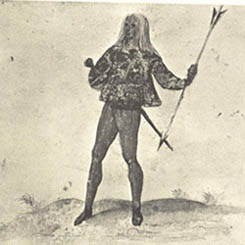
 Attachment: 36.04 KB Attachment: 36.04 KB

 Attachment: 41.53 KB Attachment: 41.53 KB
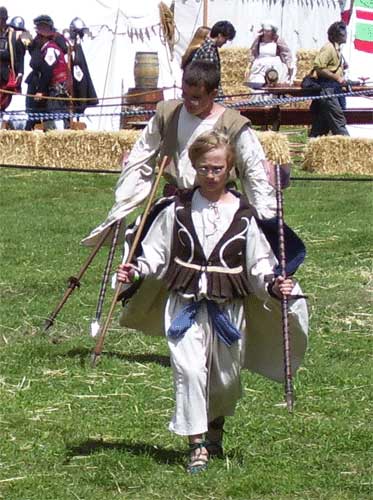
|
|
   |
 |
Sean Flynt

|
 Posted: Thu 12 Jan, 2006 6:57 am Post subject: Posted: Thu 12 Jan, 2006 6:57 am Post subject: |
 |
|
Again, this is most helpful!
My original plan was to make heads out of brass stock because I find it pretty easy to work with. I may still try that, but, at only $6 each, I think the iron heads are the best option for my first experiments. But a bronze head on a well-made, tapered shaft would be a beautiful sight!
My concern now is for finding a .5" diameter hardwood dowell in the 5' range. May have to go shorter. The socket of my heads is 3/8", so there will be a slight taper to the head and possibly a similar taper toward the fletching. I'm glad to know there's historical justification for weighting the head with wire. That's an easy way to adjust the balance!
-Sean
Author of the Little Hammer novel
https://www.amazon.com/Little-Hammer-Sean-Flynt/dp/B08XN7HZ82/ref=sr_1_1?dchild=1&keywords=little+hammer+book&qid=1627482034&sr=8-1
|
|
   |
 |
|
Bob Gresh
Location: Washington, DC Joined: 08 Jan 2006
Posts: 6
|
 Posted: Fri 13 Jan, 2006 9:53 pm Post subject: Posted: Fri 13 Jan, 2006 9:53 pm Post subject: |
 |
|
Sean:
For completeness, here is a JPG of an Irish heraldic dart, referred to earlier in this discussion. After reading the discussion here titled "Dynamics of a Javelin" if feel the wrap around the socket could be cord, though I originally took it for bronze wire. I know this is not a direct source, but irish heraldry was adopted in the 17th century, and some of these darts may have been seen by the artist. The fletching appears to be feather (gray goose?) and note the knob at the butt. The head is diamond section broadhead, which was true of the Dart of Cork City, as well. The Cork dart was about 5 feet long, perhaps a longer variety, with the tapering you have noted. I'll try to scan and post a sketch of it soon.
--Bob Gresh
 Attachment: 7.54 KB Attachment: 7.54 KB
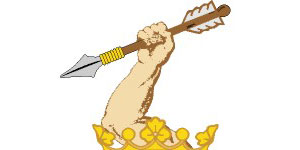
|
|
   |
 |
Sean Flynt

|
 Posted: Tue 14 Feb, 2006 3:39 pm Post subject: Posted: Tue 14 Feb, 2006 3:39 pm Post subject: |
 |
|
Bob and others: I recently found a nice, big color image from Froissart showing a man-at-arms holding a dart almost identical to the one shown in the Teilch drawing above. The Froissart illus. is ca. 1475, and shows the dart in good detail. Based on all these illustrations I've ordered three more arrowheads from Historic Enterprises--the swallowtail broadheads this time, which seem to more closely correspond to the heads shown here. The "Modified Type 16" still seem to be a very good choice for the dart depicted in the O'Neil portrait. I've fitted one of those heads to a 48" poplar dowell and tapered the dowell properly (and in a flash, thanks to the Surform tool, which is like a cheese grater!). It feels great in the hand but still needs fletching. A few halfhearted experimental tosses reveal the value of the fletching--without it the back of the dart tends to slip sideways in flight.
I'm not sure which heads I'll like best. Maybe I'll make three of each type. That'll leave three of the Modified 16s if somebody out there wants to purchase them from me and save the whopping Historic Enterprises shipping cost. More later....
-Sean
Author of the Little Hammer novel
https://www.amazon.com/Little-Hammer-Sean-Flynt/dp/B08XN7HZ82/ref=sr_1_1?dchild=1&keywords=little+hammer+book&qid=1627482034&sr=8-1
|
|
   |
 |
Bob Burns

|
 Posted: Tue 21 Feb, 2006 9:08 am Post subject: Posted: Tue 21 Feb, 2006 9:08 am Post subject: |
 |
|
My most recent acquisition is the "Irish Sword" by Arms & Armor and it is a very beautiful sword both to look at and to wield. It has a wide and very deadly crossguard on it and a pommel with some real OOOMPH to it! I love it!
http://www.arms-n-armor.com/sword085.html
Bob 
|
|
   |
 |
Nathan Robinson
myArmoury Admin


|
|
    |
 |
Sean Flynt

|
 Posted: Tue 21 Feb, 2006 9:34 am Post subject: Posted: Tue 21 Feb, 2006 9:34 am Post subject: |
 |
|
| Bob Burns wrote: | My most recent acquisition is the "Irish Sword" by Arms & Armor and it is a very beautiful sword both to look at and to wield. It has a wide and very deadly crossguard on it and a pommel with some real OOOMPH to it! I love it!
http://www.arms-n-armor.com/sword085.html
Bob  |
That's a real prize, Bob! I didn't care much for the type when I first encountered it in the MRL catalog. But the more I see originals and high quality modern interpretations, the more I want one. Kirk Lee Spencer has demonstrated that even the MRL versions can be dramatically improved, aesthetically. Hmmm...I wonder if one could make the pommel by simply sawing a short section from an iron pipe.
-Sean
Author of the Little Hammer novel
https://www.amazon.com/Little-Hammer-Sean-Flynt/dp/B08XN7HZ82/ref=sr_1_1?dchild=1&keywords=little+hammer+book&qid=1627482034&sr=8-1
|
|
   |
 |
Sean Flynt

|
 Posted: Tue 21 Feb, 2006 11:33 am Post subject: Posted: Tue 21 Feb, 2006 11:33 am Post subject: |
 |
|
These are the Historic Enterprises heads I've chosen for my dart project (these photos are from HE, and show their own mountings on regular arrow shafts--my dart shafts and mounting techniques are different). The smaller of these (Modified Type 16) resembles the head of the dart in the O'Neil portrait and is, in my opinion, a good choice for a dart of that type and period. The larger head shown below is a much larger broadhead similar to those depicted in the contemporary images referred to above. I'll have full details about all this at the Grand Unveiling of this project. 
By the way, in both orders HE gave incredibly fast and efficient service.
 Attachment: 43.4 KB Attachment: 43.4 KB
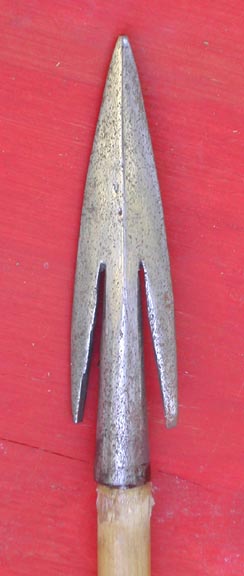
 Attachment: 54.59 KB Attachment: 54.59 KB
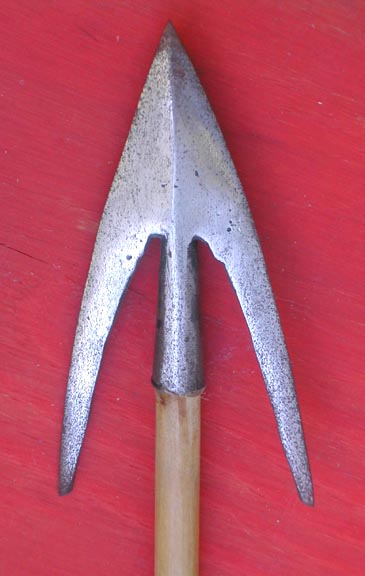
-Sean
Author of the Little Hammer novel
https://www.amazon.com/Little-Hammer-Sean-Flynt/dp/B08XN7HZ82/ref=sr_1_1?dchild=1&keywords=little+hammer+book&qid=1627482034&sr=8-1
|
|
   |
 |
Bob Burns

|
 Posted: Wed 22 Feb, 2006 11:10 pm Post subject: Posted: Wed 22 Feb, 2006 11:10 pm Post subject: |
 |
|
Wow Sean, those are wicked! No pulling those out, gotta push on through!
Bob
|
|
   |
 |
Sean Flynt

|
 Posted: Thu 23 Feb, 2006 6:35 am Post subject: Posted: Thu 23 Feb, 2006 6:35 am Post subject: |
 |
|
As for getting one of these lodged in the thigh or other large muscle...IIRC there were specific techniques for removing barbed arrows. Whether pushed or pulled, I'd rather not be involved as doctor or patient.
The swallowtail head shown above (which is actually significantly smaller than the huge v-shaped hunting broadheads of the period) is 3.5" long and around 2" wide. If that gets into your upper torso, there may not be any reason to worry about getting it out unless your buddies need the iron, in which case they could just get back to you in an hour or two for completely painless removal. I suspect that there aren't many nonlethal ways to push a 2" wide razor several inches into a person's upper body. 
I think I'm starting to understand the appeal of darts, in spite of their obvious shortcomings (low range and power). Seems to me that they'd have a higher rate of "fire" than longbows or, certainly, crossbows. The heavier weight of the dart compared to an arrow might compensate for the lack of propelling force. So, with the dart you have an inexpensive weapon that might allow good saturation of close-range targets but wouldn't require the longbow's years of training or the crossbow's technological complexity. Theoretically, a non-specialized infantryman (as opposed to bowmen, for example) could carry a few of these and launch them just before receiving a charge, then use his polearm or sword & buckler. Interestingly, the Spanish javelineer shown in the Froissart illustration mentioned above does not wear a sword and has no other visible weapon. He seems to be a dedicated javelineer and is deployed beside a slinger with big chunks of flint at his feet. Any of you who've worked with flint (not Flynt) will cringe at the thought of a rock with razor edges zipping into massed human flesh at over 100mph or whatever speed sling projectiles reach. 
-Sean
Author of the Little Hammer novel
https://www.amazon.com/Little-Hammer-Sean-Flynt/dp/B08XN7HZ82/ref=sr_1_1?dchild=1&keywords=little+hammer+book&qid=1627482034&sr=8-1
|
|
   |
 |
Jean Thibodeau

|
 Posted: Thu 23 Feb, 2006 8:06 am Post subject: Posted: Thu 23 Feb, 2006 8:06 am Post subject: |
 |
|
With Javelins running out of ammo would be reduced by the high odds of being able to recover thrown ones assuming one survives the exchange and javelins thrown back at you that miss are free ammo. 
Sort of explains the pilum being made with an easy to bend iron shaft: Might be easy to straiten later after the fight but hard to pick up and throw back right away.
Carrying 3 to 6 into battle should have been sufficient and having a number of spares in reserve with the baggage might have been the general practice.
Also a 3 to 5 foot long javelin could be used in a pinch as a thrusting weapon.
I read that slings with lead shot, could with elite slingers, out-range even the composite bow.
Sharp shards of flint would be very scary to be on the receiving end but the irregular shape would be less accurate: Not a factor for mass shooting but not ideal for single or small numbers of slingers. One might also have to be worried about the sharp flint cutting the leather " pouch " holding the projectile.
Flint is sharp because the edges are mono-molecular thin.  Just about as sharp as one can get. ( Read somewhere ??? Please fact check before accepting this as true. ) Just about as sharp as one can get. ( Read somewhere ??? Please fact check before accepting this as true. )
You can easily give up your freedom. You have to fight hard to get it back!
|
|
  |
 |
Sean Flynt

|
 Posted: Thu 23 Feb, 2006 8:22 am Post subject: Posted: Thu 23 Feb, 2006 8:22 am Post subject: |
 |
|
| Jean Thibodeau wrote: | With Javelins running out of ammo would be reduced by the high odds of being able to recover thrown ones assuming one survives the exchange and javelins thrown back at you that miss are free ammo. 
Sort of explains the pilum being made with an easy to bend iron shaft: Might be easy to straiten later after the fight but hard to pick up and throw back right away.
Carrying 3 to 6 into battle should have been sufficient and having a number of spares in reserve with the baggage might have been the general practice.
Also a 3 to 5 foot long javelin could be used in a pinch as a thrusting weapon.
I read that slings with lead shot, could with elite slingers, out-range even the composite bow.
Sharp shards of flint would be very scary to be on the receiving end but the irregular shape would be less accurate: Not a factor for mass shooting but not ideal for single or small numbers of slingers. One might also have to be worried about the sharp flint cutting the leather " pouch " holding the projectile.
Flint is sharp because the edges are mono-molecular thin.  Just about as sharp as one can get. ( Read somewhere ??? Please fact check before accepting this as true. ) Just about as sharp as one can get. ( Read somewhere ??? Please fact check before accepting this as true. ) |
Right on all counts, I'd say. And, yes, a fresh fracture of flint, obsidian, etc. is that sharp. By the way, I just read that the English longbows made short work of the Castillian javelineers and slingers during the 100 years war. Until certain firearms tech in the 19th century, it was hard, if not impossible, to beat the range and accuracy of a longbow in trained hands. Warbows had effective ranges (with single-target accuracy) of up to 250 yards, IIRC. The catch, of course, is that you need good yew for bows and stout men who've had regular training from the earliest age. It's true that the relative simplicity of the firearm helped make the longbow obsolete, but so did the problem of yew supply (largely imported by the time of Henry VIII, and monopolized by Continental speculators) and England's economic shift away from agriculture toward shepherding and middle-class commerce. More men were living in cities, thus not working all day on farms and building muscles, supplementing their diets with wild game, taking target practice, etc., and many of those who remained in rural areas were shepherding rather than, say, pushing plows. This is from The Great Warbow (a great book).
To get back to the main subject, the longbow seems not to have really caught on in Ireland, which may explain why the Irish continued to use darts throughout their 16th century wars with England. Perhaps they would have loved to have good longbows, but had no tradition of longbow use and no access to the needed wood supply. If England was at the mercy of Contintental speculators, how could the Irish compete for the strategic resource of yew?
-Sean
Author of the Little Hammer novel
https://www.amazon.com/Little-Hammer-Sean-Flynt/dp/B08XN7HZ82/ref=sr_1_1?dchild=1&keywords=little+hammer+book&qid=1627482034&sr=8-1
|
|
   |
 |
|
|
You cannot post new topics in this forum
You cannot reply to topics in this forum
You cannot edit your posts in this forum
You cannot delete your posts in this forum
You cannot vote in polls in this forum
You cannot attach files in this forum
You can download files in this forum
|
All contents © Copyright 2003-2024 myArmoury.com — All rights reserved
Discussion forums powered by phpBB © The phpBB Group
Switch to the Basic Low-bandwidth Version of the forum
|

